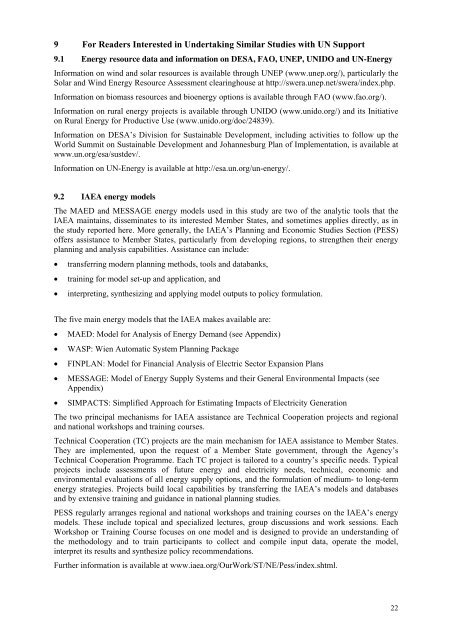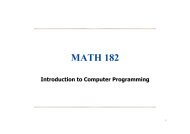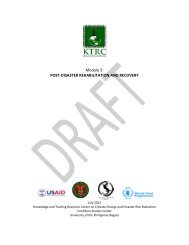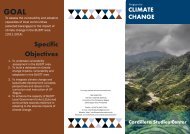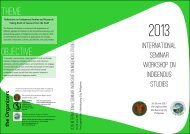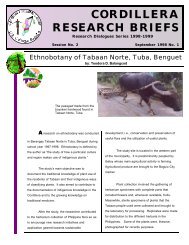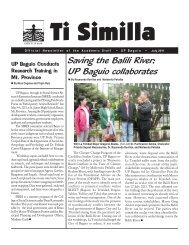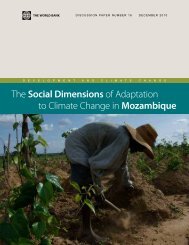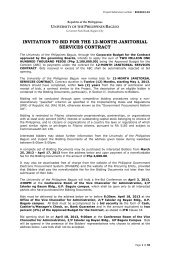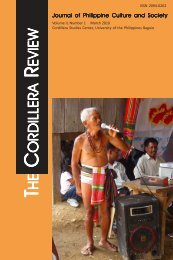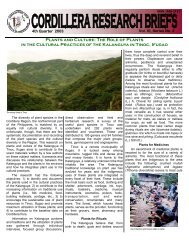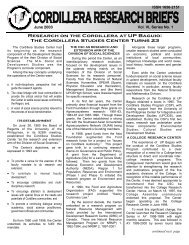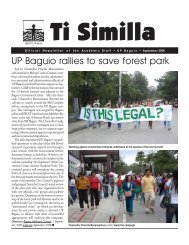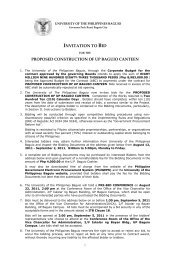Ghana - UNEP
Ghana - UNEP
Ghana - UNEP
- No tags were found...
Create successful ePaper yourself
Turn your PDF publications into a flip-book with our unique Google optimized e-Paper software.
9 For Readers Interested in Undertaking Similar Studies with UN Support9.1 Energy resource data and information on DESA, FAO, <strong>UNEP</strong>, UNIDO and UN-EnergyInformation on wind and solar resources is available through <strong>UNEP</strong> (www.unep.org/), particularly theSolar and Wind Energy Resource Assessment clearinghouse at http://swera.unep.net/swera/index.php.Information on biomass resources and bioenergy options is available through FAO (www.fao.org/).Information on rural energy projects is available through UNIDO (www.unido.org/) and its Initiativeon Rural Energy for Productive Use (www.unido.org/doc/24839).Information on DESA’s Division for Sustainable Development, including activities to follow up theWorld Summit on Sustainable Development and Johannesburg Plan of Implementation, is available atwww.un.org/esa/sustdev/.Information on UN-Energy is available at http://esa.un.org/un-energy/.9.2 IAEA energy modelsThe MAED and MESSAGE energy models used in this study are two of the analytic tools that theIAEA maintains, disseminates to its interested Member States, and sometimes applies directly, as inthe study reported here. More generally, the IAEA’s Planning and Economic Studies Section (PESS)offers assistance to Member States, particularly from developing regions, to strengthen their energyplanning and analysis capabilities. Assistance can include:• transferring modern planning methods, tools and databanks,• training for model set-up and application, and• interpreting, synthesizing and applying model outputs to policy formulation.The five main energy models that the IAEA makes available are:• MAED: Model for Analysis of Energy Demand (see Appendix)• WASP: Wien Automatic System Planning Package• FINPLAN: Model for Financial Analysis of Electric Sector Expansion Plans• MESSAGE: Model of Energy Supply Systems and their General Environmental Impacts (seeAppendix)• SIMPACTS: Simplified Approach for Estimating Impacts of Electricity GenerationThe two principal mechanisms for IAEA assistance are Technical Cooperation projects and regionaland national workshops and training courses.Technical Cooperation (TC) projects are the main mechanism for IAEA assistance to Member States.They are implemented, upon the request of a Member State government, through the Agency’sTechnical Cooperation Programme. Each TC project is tailored to a country’s specific needs. Typicalprojects include assessments of future energy and electricity needs, technical, economic andenvironmental evaluations of all energy supply options, and the formulation of medium- to long-termenergy strategies. Projects build local capabilities by transferring the IAEA’s models and databasesand by extensive training and guidance in national planning studies.PESS regularly arranges regional and national workshops and training courses on the IAEA’s energymodels. These include topical and specialized lectures, group discussions and work sessions. EachWorkshop or Training Course focuses on one model and is designed to provide an understanding ofthe methodology and to train participants to collect and compile input data, operate the model,interpret its results and synthesize policy recommendations.Further information is available at www.iaea.org/OurWork/ST/NE/Pess/index.shtml.22


